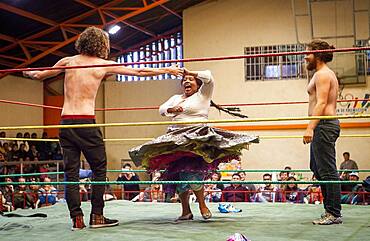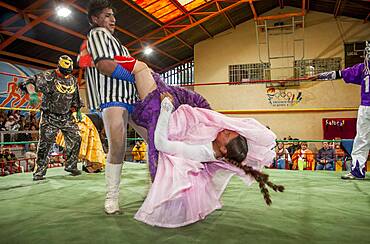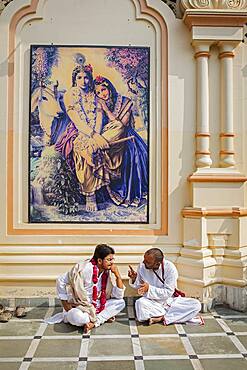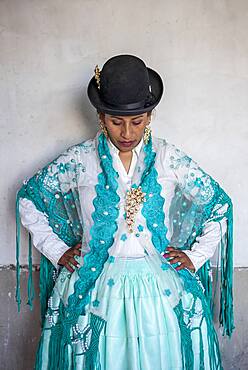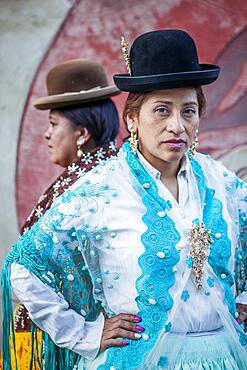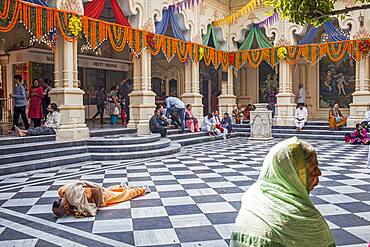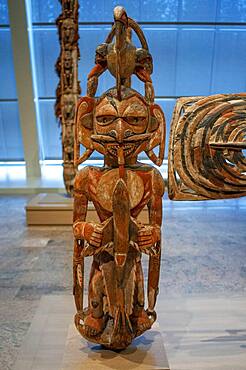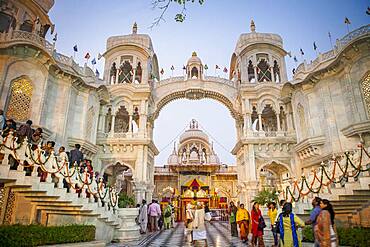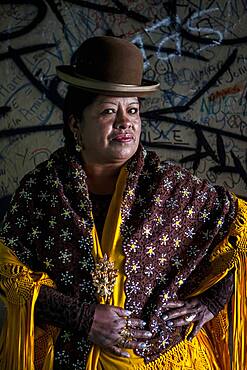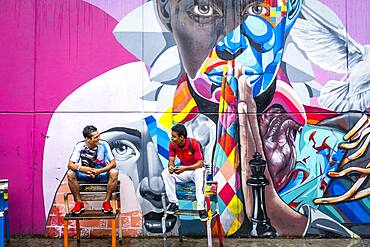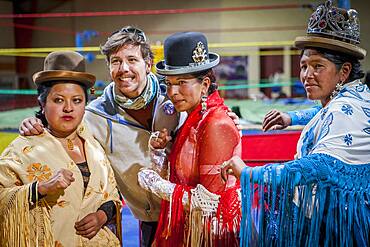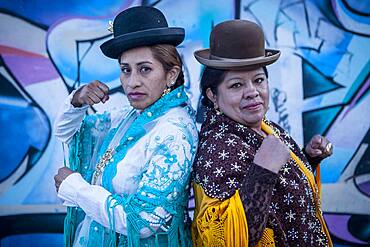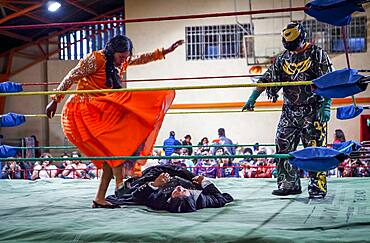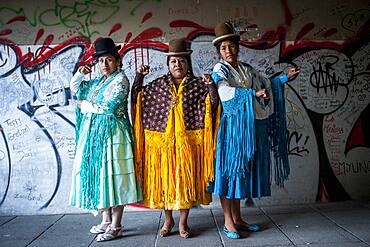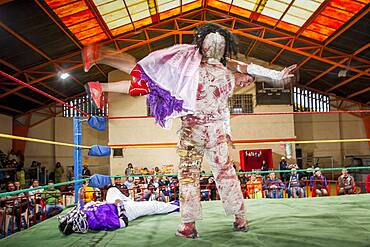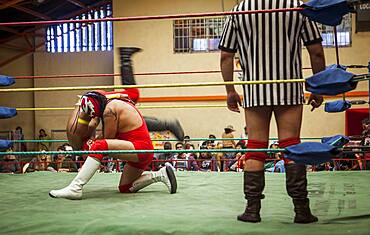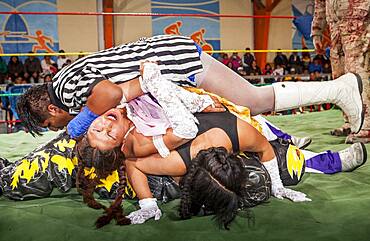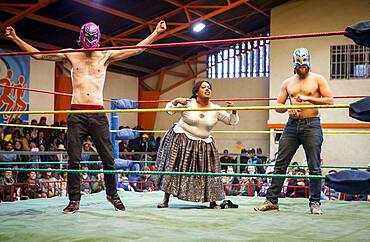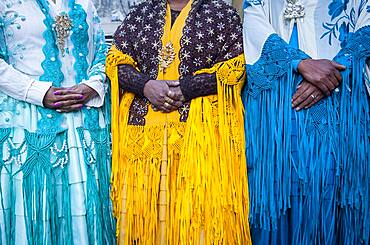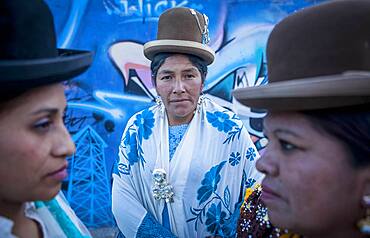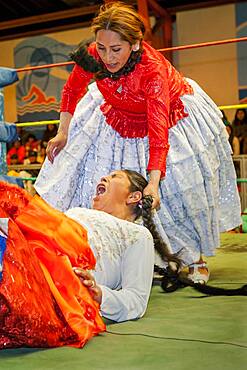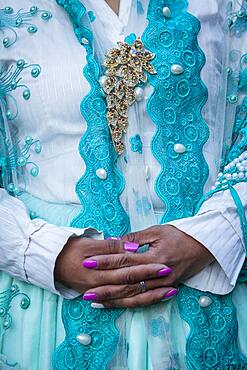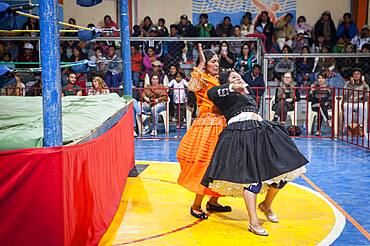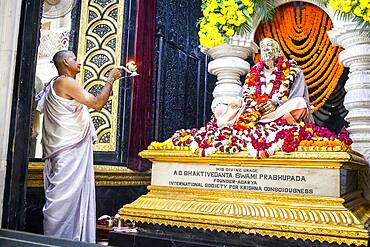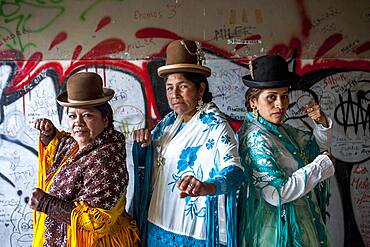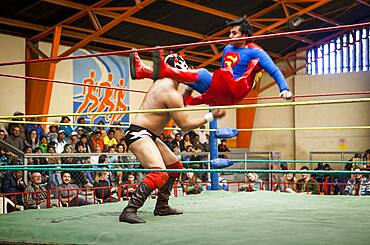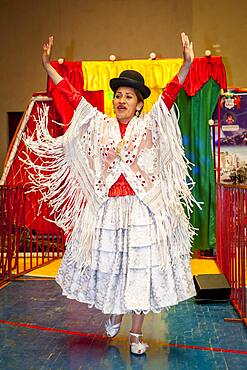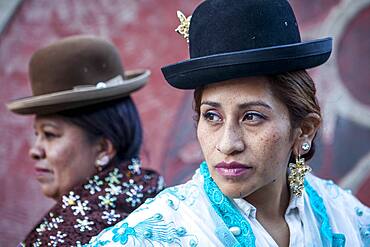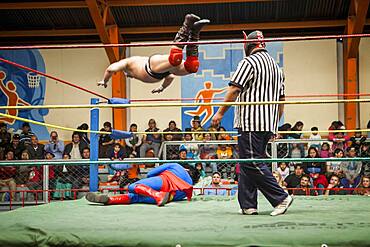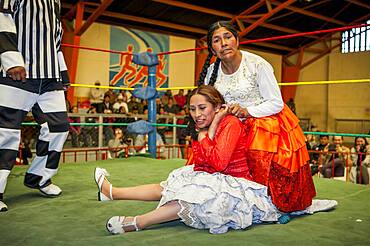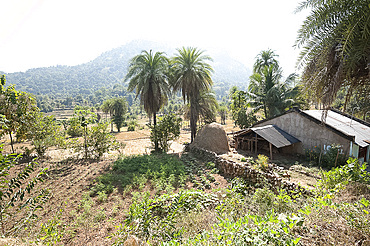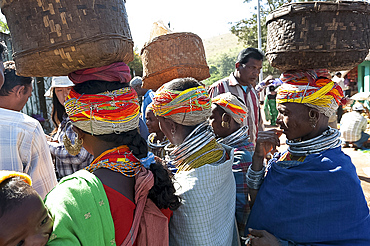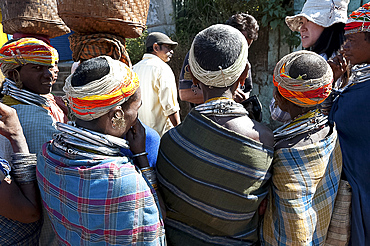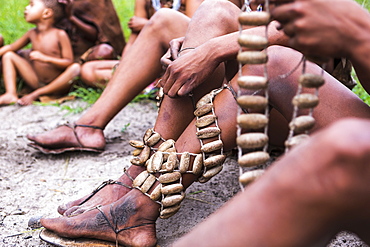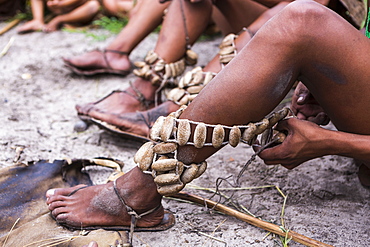Recent searches
Loading...
1350-832 - Lucha Libre. Two spontaneous up to the ring to dace with the cholita Angela la Folclorista to celebrate the victory, Sports center La Ceja, El Alto, La Paz, Bolivia
1350-840 - Lucha Libre. male and the cholita Celia la Simpatica wrestlers in combat, Sports center La Ceja, El Alto, La Paz, Bolivia
1350-1861 - Yonna dance, also called Chichamaya, carries a considerable symbolic charge for the Wayuu indigenous people of Colombia, representing three basic principles for this tribal group: Social equality, collective solidarity and the improvement of relations between the human being and the Cosmos.
1350-1692 - Believers speaking, in ISKCON temple, Sri Krishna Balaram Mandir,Vrindavan,Mathura, Uttar Pradesh, India
1350-817 - At left Dina , in the middle Benita la Intocable, at right Angela la Folclorista, cholitas females wrestlers, El Alto, La Paz, Bolivia
1350-846 - Lucha Libre. After the show. A follower is photographed with cholitas fighters. Down Julieta, Celia la Simpatica, and Dina with blue dress , cholitas females wrestlers ,Sports center La Ceja, El Alto, La Paz, Bolivia
1350-812 - Benita la Intocable, cholita female wrestler,El Alto, La Paz, Bolivia
1350-1862 - Yonna dance, also called Chichamaya, carries a considerable symbolic charge for the Wayuu indigenous people of Colombia, representing three basic principles for this tribal group: Social equality, collective solidarity and the improvement of relations between the human being and the Cosmos.
1350-841 - Lucha Libre. Male fighter stretch the hair of cholita Julieta, wrestlers in combat, Sports center La Ceja, El Alto, La Paz, Bolivia
1350-826 - Detail of dresses and feet. At left Benita la Intocable , in the middle Angela la Folclorista, and at right Dina, cholitas females wrestlers, El Alto, La Paz, Bolivia
1350-1866 - Yonna dance, also called Chichamaya, carries a considerable symbolic charge for the Wayuu indigenous people of Colombia, representing three basic principles for this tribal group: Social equality, collective solidarity and the improvement of relations between the human being and the Cosmos.
1350-819 - At right Benita la Intocable , at left Angela la Folclorista, cholitas females wrestlers, El Alto, La Paz, Bolivia
1350-1870 - Yonna dance, also called Chichamaya, carries a considerable symbolic charge for the Wayuu indigenous people of Colombia, representing three basic principles for this tribal group: Social equality, collective solidarity and the improvement of relations between the human being and the Cosmos.
1350-1686 - Praying, ISKCON temple, Sri Krishna Balaram Mandir,Vrindavan,Mathura, Uttar Pradesh, India
1350-925 - Arco de Mejillones,calle Mejillones, Potosi, Bolivia
1350-838 - Lucha Libre. Combat between Dina with orange skirt and Benita la Intocable , cholitas females wrestlers ,with referee in the middle, Sports center La Ceja, El Alto, La Paz, Bolivia
1350-2073 - New Ireland Malagan funerary statue in at the Metropolitan Museum of Art museum, New York, USA. New Ireland is part of the Bismarck Archipelago, situated north of New Guinea, and has an estimated population of 100,000. The Dutch first encountered the island in 1616, and today New Ireland is a province of Papua New Guinea. Nineteen different languages are spoken on the island, and it is divided by a chain of mountains into three distinct regions: northern, central, and southeastern. The art of New Ireland traditionally centered on mortuary ceremonies and feasts to honor the dead. In northern New Ireland, the name given to these elaborate ceremonies is malagan, which is also the term used for the carved and painted sculptures associated with the ceremonies.
1350-1868 - Yonna dance, also called Chichamaya, carries a considerable symbolic charge for the Wayuu indigenous people of Colombia, representing three basic principles for this tribal group: Social equality, collective solidarity and the improvement of relations between the human being and the Cosmos.
1350-1858 - Yonna dance, also called Chichamaya, carries a considerable symbolic charge for the Wayuu indigenous people of Colombia, representing three basic principles for this tribal group: Social equality, collective solidarity and the improvement of relations between the human being and the Cosmos.
1350-1693 - ISKCON temple, Sri Krishna Balaram Mandir,Vrindavan,Mathura, Uttar Pradesh, India
1350-813 - Angela la Folclorista, cholita female wrestler, El Alto, La Paz, Bolivia
1350-822 - At left Dina , in the middle Benita la Intocable, at right Angela la Folclorista, cholitas females wrestlers, El Alto, La Paz, Bolivia
1350-1353 - Friends, Street art, mural, graffiti, Comuna 13, Medellín, Colombia
1350-830 - Lucha Libre. Combat between El Prisionero and the cholita Angela la folclorista, wrestlers ,Sports center La Ceja, El Alto, La Paz, Bolivia
1350-814 - At left Benita la Intocable , in the middle Angela la Folclorista, and at right Dina, cholitas females wrestlers, El Alto, La Paz, Bolivia
1350-1691 - Group of women praying, in ISKCON temple, Sri Krishna Balaram Mandir,Vrindavan,Mathura, Uttar Pradesh, India
1350-845 - Lucha Libre. After the show. A follower is photographed with cholitas fighters. At left Julieta, in the middle Celia la Simpatica, and Dina , cholitas females wrestlers ,Sports center La Ceja, El Alto, La Paz, Bolivia
1350-829 - At left Benita la Intocable , and at right Angela la Folclorista, cholitas females wrestlers, El Alto, La Paz, Bolivia
1350-834 - Lucha Libre. Combat between Dina with orange dress and Julieta, cholitas females wrestlers ,with a referee, Sports center La Ceja, El Alto, La Paz, Bolivia
1350-1350 - Street art, mural, graffiti, Comuna 13, Medellín, Colombia
1350-1869 - Yonna dance, also called Chichamaya, carries a considerable symbolic charge for the Wayuu indigenous people of Colombia, representing three basic principles for this tribal group: Social equality, collective solidarity and the improvement of relations between the human being and the Cosmos.
1350-815 - At left Benita la Intocable , in the middle Angela la Folclorista, and at right Dina, cholitas females wrestlers, El Alto, La Paz, Bolivia
1350-843 - Lucha Libre. Angela la Simpatica and La Momia fighting, males and cholitas females wrestlers in combat, Sports center La Ceja, El Alto, La Paz, Bolivia
1350-827 - At left Benita la Intocable , and at right Angela la Folclorista, cholitas females wrestlers, El Alto, La Paz, Bolivia
1350-1344 - Street art, mural, graffiti, Comuna 13, Medellín, Colombia
1350-895 - Lucha Libre. Wrestlers in combat, and referee, Sports center La Ceja, El Alto, La Paz, Bolivia
1350-844 - Lucha Libre. Julieta and Celia la Simpatica whith pink skirt during a crazy combat, agaist males wrestlers, Sports center La Ceja, El Alto, La Paz, Bolivia
1350-1687 - Praying, ISKCON temple, Sri Krishna Balaram Mandir,Vrindavan,Mathura, Uttar Pradesh, India
1350-831 - Lucha Libre.Two spontaneous up to the ring to help the cholita Angela la Folclorista during the combat again the wrestler called El Prisionero, Sports center La Ceja, El Alto, La Paz, Bolivia
1350-825 - Detail of dresses and hands. At left Benita la Intocable , in the middle Angela la Folclorista, and at right Dina, cholitas females wrestlers, El Alto, La Paz, Bolivia
1350-1863 - Yonna dance, also called Chichamaya, carries a considerable symbolic charge for the Wayuu indigenous people of Colombia, representing three basic principles for this tribal group: Social equality, collective solidarity and the improvement of relations between the human being and the Cosmos.
1350-828 - At left Benita la Intocable , in the middle Dina, and at right Angela la Folclorista, cholitas females wrestlers, El Alto, La Paz, Bolivia
1350-837 - Lucha Libre. Combat between Dina with orange skirt and Benita la Intocable , cholitas females wrestlers ,Sports center La Ceja, El Alto, La Paz, Bolivia
1350-821 - At left Angela la Folclorista , in the middle Benita la Intocable, and at right Dina, cholitas females wrestlers, El Alto, La Paz, Bolivia
1350-823 - Benita la Intocable, detail of her dress and hands, cholita female wrestler, El Alto, La Paz, Bolivia
1350-1864 - Yonna dance, also called Chichamaya, carries a considerable symbolic charge for the Wayuu indigenous people of Colombia, representing three basic principles for this tribal group: Social equality, collective solidarity and the improvement of relations between the human being and the Cosmos.
1350-833 - Lucha Libre. Combat between Dina with orange dress and Julieta, cholitas females wrestlers ,Sports center La Ceja, El Alto, La Paz, Bolivia
1350-1688 - Praying, ISKCON temple, Sri Krishna Balaram Mandir,Vrindavan,Mathura, Uttar Pradesh, India
1350-1867 - Yonna dance, also called Chichamaya, carries a considerable symbolic charge for the Wayuu indigenous people of Colombia, representing three basic principles for this tribal group: Social equality, collective solidarity and the improvement of relations between the human being and the Cosmos.
1350-1689 - Praying, statue of A. C. Bhakivedanta Swami Prabhupada the founder of hare Krishna movement, in ISKCON temple, Sri Krishna Balaram Mandir,Vrindavan,Mathura, Uttar Pradesh, India
1350-816 - At left Angela la Folclorista , in the middle Dina, and at right Benita la Intocable, cholitas females wrestlers, El Alto, La Paz, Bolivia
1350-893 - Lucha Libre. Wrestlers in combat, Sports center La Ceja, El Alto, La Paz, Bolivia
1350-1690 - Group of women praying, in ISKCON temple, Sri Krishna Balaram Mandir,Vrindavan,Mathura, Uttar Pradesh, India
1350-835 - Lucha Libre. Benita la Intocable acclaimed by the public before starting the combat, cholitas females wrestlers ,Sports center La Ceja, El Alto, La Paz, Bolivia
1350-820 - At right Benita la Intocable , at left Angela la Folclorista, cholitas females wrestlers, El Alto, La Paz, Bolivia
1350-894 - Lucha Libre. Wrestlers in combat, and referee, Sports center La Ceja, El Alto, La Paz, Bolivia
1350-836 - Lucha Libre. Combat between Dina with orange skirt and Benita la Intocable , cholitas females wrestlers ,with referee, Sports center La Ceja, El Alto, La Paz, Bolivia
805-309 - Head of Bonda tribeswoman wearing traditional beaded cap held with metal clips, large earrings and metal and bead necklaces, Rayagader, Orissa, India, Asia
805-402 - Saura tribal village in rural Orissa, hand winnowed rice drying in the central area, Orissan style haystacks behind, Orissa, India, Asia
805-319 - Bonda tribeswomen wearing traditional beaded caps and metal necklaces, selling village-made alcohol at weekly market, Rayagader, Orissa, India, Asia
805-403 - Vegetables growing in communal village plot in Saura tribal village, rural Orissa, India, Asia
805-323 - Bonda tribeswoman wearing blue cotton shawl over traditional bead costume, with beaded cap, large earrings and metal necklaces, Rayagader, Orissa, India, Asia
805-330 - Mali tribeswomen selling chillies and sweet potatoes at weekly market, Rayagader, Orissa, India, Asia
805-324 - Mali tribeswomen selling vegetables at weekly market, Rayagader, Orissa, India, Asia
805-331 - Bonda tribeswomen wearing traditional beaded caps and metal necklaces, with baskets on their heads at weekly market, Rayagader, Orissa, India, Asia
805-404 - Communal village cattle threshing rice by walking on it in Saura tribal village, rural Orissa, India, Asia
805-332 - Bonda tribeswomen wearing traditional beaded caps and metal necklaces, selling beads to tourists at weekly market, Rayagader, Orissa, India, Asia
832-391181 - Sondor, Ruins of the Chanca Culture, Ruta 100, Andahuaylas Province, Peru, South America
832-391178 - Sondor, Ruins of the Chanca Culture, Ruta 100, Andahuaylas Province, Peru, South America
832-391180 - Sondor, Ruins of the Chanca Culture, Ruta 100, Andahuaylas Province, Peru, South America
832-391182 - Sondor, Ruins of the Chanca Culture, Ruta 100, Andahuaylas Province, Peru, South America
832-391179 - Sondor, Ruins of the Chanca Culture, Ruta 100, Andahuaylas Province, Peru, South America
832-391177 - Sondor, Ruins of the Chanca Culture, Ruta 100, Andahuaylas Province, Peru, South America
1178-30607 - USA, New Mexico, Bandelier National Monument, Cliff dwellings in Bandelier National Monument
1178-30605 - USA, New Mexico, Bandelier National Monument, Cliff dwellings in Bandelier National Monument
1178-30606 - USA, New Mexico, Bandelier National Monument, Woman climbing ladder to cliff dwellings in Bandelier National Monument
1174-9172 - Locals going down the Zambezi River in traditional mokoro canoes, Zambia
1174-8739 - Rear view of a San Bushman, head and shoulders
1174-8421 - Leg decorations, traditional tribal ceremonial garters worn by the San People bushmen
1174-8426 - close up of Bushman holding scorpion, Botswana
1174-8740 - Five year old boy riding on shoulders of a San bushman
1174-8431 - A boy and his mother, tourists on a walking trail following members of the San people, bushmen
1174-8432 - Tourists on a walking trail with members of the San people, bushmen
1174-8425 - close up of Bushman holding scorpion, Botswana
1174-8429 - Tourists on a walking trail with members of the San people, bushmen
1174-8738 - A San Bushman holding bow and arrow, Kalahari Desert
1174-8424 - close up of Bushman creating fire, Botswana
1174-8433 - Tourists on a walking trail with members of the San people, bushmen in Botswana
1174-8420 - Leg decorations, traditional tribal ceremonial garters worn by the San People bushmen
1174-8422 - close up of Bushman creating fire, Botswana
1174-8430 - Tourists on a walking trail with members of the San people, bushmen
1174-8428 - Rear view of teen girl walking with a group of bushmen from the San people
1174-8427 - close up of Bushman holding scorpion, Botswana
1174-8423 - San People, a bushman creating fire from dry kindling, a cultural demonstration
1174-8419 - Tourists on a walking trail with members of the San people, bushmen
832-387303 - Monastery Santuari de Bonany at sunset, near Petra, drone picture, Majorca, Balearic Islands, Spain, Europe
832-386983 - Inside of Bedoiun tent, Agafay desert, Morocco, Africa
832-387302 - Monastery Santuari de Bonany in the evening light, near Petra, drone picture, Majorca, Balearic Islands, Spain, Europe
832-387301 - Monastery Santuari de Bonany in the evening light, near Petra, drone picture, Majorca, Balearic Islands, Spain, Europe
832-387304 - Monastery Santuari de Bonany from above, near Petra, drone picture, Majorca, Balearic Islands, Spain, Europe
